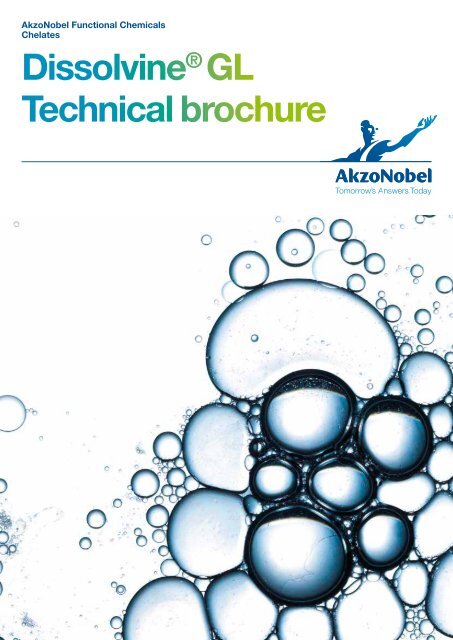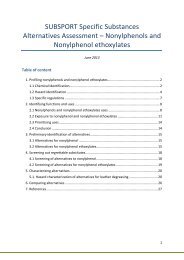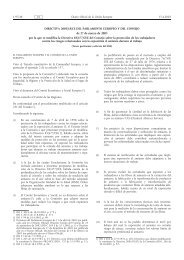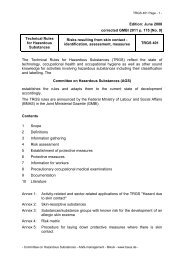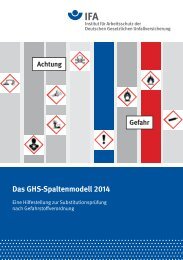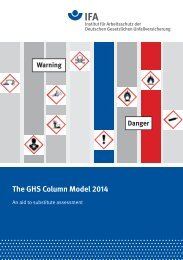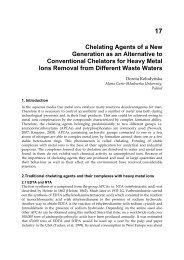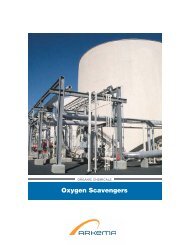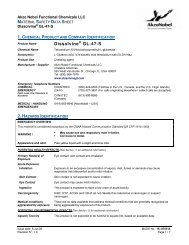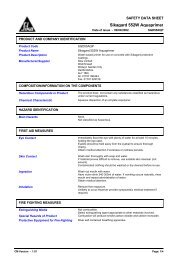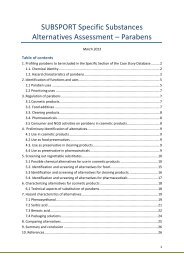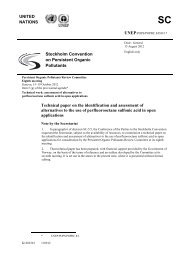Dissolvine® GL Technical brochure - AkzoNobel
Dissolvine® GL Technical brochure - AkzoNobel
Dissolvine® GL Technical brochure - AkzoNobel
Create successful ePaper yourself
Turn your PDF publications into a flip-book with our unique Google optimized e-Paper software.
<strong>AkzoNobel</strong> Functional Chemicals<br />
Chelates<br />
Dissolvine ® <strong>GL</strong><br />
<strong>Technical</strong> <strong>brochure</strong>
Dissolvine ® <strong>GL</strong><br />
1. Introduction<br />
Dissolvine ® aminopolycarboxylate-based chelates are used<br />
extensively to control metal ions in water-based systems for<br />
countless applications. They are highly effective in the control<br />
of water hardness ions and find wide application in cleaning<br />
surfaces, descaling boilers, processing textile and preventing<br />
scale in heating systems. In another area, the control of metal<br />
reactivity, they are important processing tools for reducing<br />
the detrimental effect of metals in pulp bleaching for paper<br />
manufacturing, improving personal care formulations, stabilizing<br />
food products and for pharmaceutical formulations. Finally, they<br />
are also used extensively in metalworking areas, ranging from<br />
metal plating, dosing essential elements to plants and supplying<br />
iron for the development of photographic films and paper using<br />
silver halide technology.<br />
The sheer diversity of application demonstrates the versatility of<br />
the Dissolvine ® chelate product range.<br />
Although classical aminopolycarboxylates are excellent<br />
performers in terms of cost effectiveness and versatility, they<br />
do not always meet all the needs of the customer. Recognizing<br />
this fact, <strong>AkzoNobel</strong> is constantly seeking to develop even more<br />
environmentally benign products with an excellent chelating<br />
performance to complement our existing product range.<br />
Dissolvine ® <strong>GL</strong> has been developed as part of this continuing<br />
quest to find new and improved products. Produced from<br />
natural and sustainable raw materials, Dissolvine ® <strong>GL</strong> is readily<br />
biodegradable, with a high solubility over a wide pH range.<br />
Compared to EDTA and NTA, Dissolvine ® <strong>GL</strong> performs better<br />
when it comes to hard surface cleaning. It does not sensitize<br />
human skin, demonstrates enhanced biocidal boosting power<br />
and improved biodegradability properties. Compared to<br />
phosphates and phosphonates, it is a far more effective chelating<br />
agent. Also, it does not contribute to eutrophication and has<br />
improved toxicological properties.<br />
2. Product description<br />
Chemical structure<br />
The active ingredient in Dissolvine ® <strong>GL</strong> is glutamic acid<br />
diacetic acid, tetra sodium salt (<strong>GL</strong>DA). As shown below,<br />
<strong>GL</strong>DA has four carboxylic acid groups. In combination with<br />
the nitrogen atom these acid groups can form strong bonds<br />
with di- and trivalent metals.<br />
Chemical structure:<br />
Chemical name: L-glutamic acid N,N-diacetic acid,<br />
tetra sodium salt; <strong>GL</strong>DA<br />
CAS No: 51981-21-6<br />
Chemical formula: C 9<br />
H 9<br />
NO 8<br />
Na 4<br />
Molecular weight: 351.1 g/mol<br />
Ecological footprint<br />
Dissolvine ® <strong>GL</strong> is based on the food-approved natural<br />
amino acid salt, monosodium L-glutamate (MSG). MSG<br />
is produced by biochemical conversion of vegetable<br />
material (such as sugar beet waste). This results in a good<br />
biological breakdown as is confirmed by the Closed Bottle<br />
biodegradability test (OECD 301D).<br />
The greener nature of Dissolvine ® <strong>GL</strong>, compared to a wellknown<br />
chelate such as EDTA has also been quantified using<br />
internationally accepted standards:<br />
• A biobased content analysis using ASTM-D6866<br />
executed by a third party confirms the green nature of<br />
Dissolvine <strong>GL</strong>. The measured mean biobased content of<br />
53 percent is very close to the theoretical percentage of<br />
green carbon atoms in <strong>GL</strong>DA, i.e. the ones derived from<br />
vegetable MSG. These account for 5 out of a total of 9<br />
carbon atoms.<br />
Figure 1: <strong>GL</strong>DA-Na 4<br />
and green character, according to the<br />
Bra Miljöval protocol
<strong>Technical</strong> Brochure Dissolvine ® <strong>GL</strong> 3<br />
Table 1: Dissolvine ® <strong>GL</strong> Product Characteristics<br />
Product name Dissolvine ® <strong>GL</strong>-38 Dissolvine ® <strong>GL</strong>-PD Dissolvine ® <strong>GL</strong>-47-S Dissolvine ® <strong>GL</strong>-PD-S<br />
Chemical formula <strong>GL</strong>DA-Na 4<br />
<strong>GL</strong>DA-Na 4<br />
<strong>GL</strong>DA-Na 4<br />
<strong>GL</strong>DA-Na 4<br />
Physical form liquid solid liquid solid<br />
Appearance clear liquid white to off white powder clear liquid white to off white<br />
powder<br />
Odor slightly ammonia like odorless slightly ammonia like odorless<br />
NTA (wt %) < 2.5 < 5.0 < 0.10 < 0.20<br />
Assay (wt %)* 38.0 min 74.0 min 47.4 min 80.0 min<br />
pH (1% wv aqueous solution) 11.0 – 12.0 11.0-12.0 11.0 – 12.0 11.0-12.0<br />
Liquid density** (kg/m3) approx. 1330 - approx. 1400 -<br />
Poured bulk density (kg/m3) - approx. 650 - approx. 650<br />
Viscosity** (mPa.s) approx. 41 - 90-150 -<br />
Freezing point (°C) < -15 - < -15 -<br />
Solubility in water** (g/l water) miscible in all ratios approx. 1000 miscible in all ratios approx. 1000<br />
Solubility in water at low pH** (wt%) miscible in all ratios > 25 miscible in all ratios > 25<br />
Solubility in Ethylene Glycol** (wt%) miscible in all ratios approx. 45 miscible in all ratios approx. 45<br />
Solubility in 5M NaOH** (wt%) miscible in all ratios approx. 60 miscible in all ratios approx. 60<br />
COD (mg/g) 280 – 310 545-605 345-385 590-655<br />
* based on Fe-sequestering capacity; ** at 20°C<br />
• Accordingto the Bra Miljöval protocol<br />
drawn up by the Swedish Society for<br />
Nature Conservation (SSNC), 86 percent<br />
of Dissolvine <strong>GL</strong> ® is based on renewable<br />
resources, a much higher proportion in<br />
comparison with other chelating agents.<br />
See figure 1.<br />
• An Eco-Efficiency Analysis (EEA) conducted<br />
on a variety of alternative chelating<br />
agents concluded that <strong>GL</strong>DA is the most<br />
environmentally benign chelating agent. The<br />
EEA assessed the ecological and economic<br />
profiles of alternative systems delivering the<br />
same customer benefits. The references to<br />
external publications for the EEA analysis<br />
are SOFW (10-2009), Inform (10-2009) and<br />
SPC (11-2009).<br />
Dissolvine ® <strong>GL</strong> is a shining<br />
example of a sustainable,<br />
innovative material that can add<br />
value to your product. It offers<br />
added value from an economic<br />
and ecological perspective and<br />
is therefore classified as an<br />
eco-premium solution.
Dissolvine ® <strong>GL</strong> <strong>Technical</strong> Brochure 4<br />
3. Chemical and physical properties<br />
Table 1 lists the major chemical and physical properties of the<br />
Dissolvine ® <strong>GL</strong> product range. Dissolvine ® <strong>GL</strong>-38 and Dissolvine ®<br />
<strong>GL</strong>-47-S are standard multi-purpose liquid chelating agents.<br />
Dissolvine ® <strong>GL</strong>-PD and Dissolvine ® <strong>GL</strong>-PD-S are spray dried<br />
equivalents of the liquid products, which are convenient for the<br />
preparation of highly concentrated formulations (solid or liquid).<br />
The solid products readily dissolve in water to yield a clear slightly yellow<br />
liquid. These solid products are hygroscopic and should be stored in<br />
closed bags or containers until they are used.<br />
Viscosity<br />
Viscosity is an important parameter for handling products and depends<br />
on concentration and temperature. Figures 3A and B show the viscosity<br />
of various concentrations of tetra sodium <strong>GL</strong>DA solutions as a function<br />
of temperature based on Dissolvine ® <strong>GL</strong>-PD and Dissolvine ® <strong>GL</strong>-PD-S,<br />
respectively.<br />
Liquid density<br />
The density of the liquid can be used as a quick reference to check the<br />
concentration of the material. See Figure 2.<br />
Figure 3A: : Graph of the viscosity of various concentrations of Dissolvine ® <strong>GL</strong><br />
at different temperatures, using <strong>GL</strong>-PD as starting material<br />
Figure 2: Density of Dissolvine ® <strong>GL</strong> plotted against concentration at different<br />
temperatures.<br />
Figure 3B: Graph of the viscosity of various concentrations of Dissolvine ® <strong>GL</strong><br />
at different temperatures, using <strong>GL</strong>-PD-S as starting material.
Dissolvine ® <strong>GL</strong> <strong>Technical</strong> Brochure 5<br />
Solubility<br />
Dissolvine ® <strong>GL</strong> (<strong>GL</strong>DA) has a high water solubility over a wide pH range<br />
(see Figure 4), which is much higher than the classical chelates EDTA<br />
and NTA. Dissolvine ® <strong>GL</strong> also has a high solubility in sodium hydroxide<br />
based systems. Tests with <strong>GL</strong>DA-Na4 have shown much higher solubility<br />
compared to products such as EDTA and NTA sodium salts of (see Figure<br />
5). Good solubility is an important property in the cleaning products as<br />
it enables formulators to make highly concentrated products, which<br />
reduces packaging and transport cost and contributes positively to<br />
conserving the planet.<br />
Experiments with aqueous <strong>GL</strong>DA solutions at temperatures of up to<br />
170°C for 6 hours, or one week at 150°C, show that <strong>GL</strong>DA is extremely<br />
stable especially under alkaline conditions. This is confirmed by literature<br />
on the use of <strong>GL</strong>DA in circulating aqueous systems, e.g. steam generating<br />
and cooling systems (US2004/0011743).<br />
Acid/base dissociation constants<br />
Chelating agents are acids, which can dissociate in water to the chelate<br />
anion and x hydrogen ions (H + ). The extent of acid dissociation is<br />
expressed as the equilibrium constant pK a<br />
. The theoretical values are<br />
shown in Table 2. From the pKa values the ion species distribution of the<br />
<strong>GL</strong>DA molecule as function of the pH can be calculated, see Figure 6.<br />
Figure 4: Solubility of chelating agents, expressed as their acids, in water at<br />
various pH levels<br />
Table 2: The acid dissociation constants (pK a<br />
)* for <strong>GL</strong>DA, NTA and EDTA.<br />
<strong>GL</strong>DA NTA EDTA<br />
pK a1<br />
9.4 9.7 10.2<br />
pK a2<br />
5.0 2.5 6.2<br />
pK a3<br />
3.5 1.8 2.7<br />
pK a4<br />
2.6 1.0 2.0<br />
pK a5<br />
not available 1.5<br />
pK a6<br />
0.0<br />
* A.E. Martell, R.M. Smith, NIST Critically selected stability constants of metal<br />
complexes (NIST standard reference database 46, Version 7.0, 2003)<br />
pK a<br />
values: as determined at an ionic strength of 0.1M and at a temperature of<br />
25°C, or if not available at 20°C.<br />
Figure 5: Solubility of chelating agents in concentrated sodium hydroxide<br />
solution.<br />
Figure 6: The ion species distribution for <strong>GL</strong>DA<br />
Thermal stability<br />
Like most Dissolvine ® aminopolycarboxylates, Dissolvine ® <strong>GL</strong> is very<br />
stable under both acid and alkaline conditions. This is a prerequisite for<br />
stable formulations based on Dissolvine ® <strong>GL</strong>.<br />
The thermal stability of the <strong>GL</strong>DA-Na 4<br />
powder has been determined using<br />
Thermal Gravimetric Analysis (TGA) and Differential Scanning Calorimetry<br />
(DSC). Dissolvine ® <strong>GL</strong> solid loses all its water (10-15%) at temperatures<br />
around 200°C and starts to decompose at temperatures above 300°C.
Dissolvine ® <strong>GL</strong> <strong>Technical</strong> Brochure 6
Dissolvine ® <strong>GL</strong> <strong>Technical</strong> Brochure 7<br />
Table 3: Sequestering values (mg/g product) Dissolvine ® <strong>GL</strong> (<strong>GL</strong>DA), Dissolvine ® A-40 (NTA)<br />
and Dissolvine ® E-39 (EDTA) for several metal ions and CaCO 3<br />
.<br />
Product Assay (wt%) CaCO 3<br />
Ca 2+ Cu 2+ Fe 3+ Mg 2+ Mn 2+ Zn 2+<br />
Dissolvine ® <strong>GL</strong>-38 38 108 43 69 60 26 59 71<br />
Dissolvine ® <strong>GL</strong>-47-S 47 134 54 85 75 33 73 88<br />
Dissolvine ® A-40 40 156 62 99 87 38 85 102<br />
Dissolvine ® E-39 39 103 41 65 57 25 56 67<br />
Chelating power<br />
Chelating agents are added to products or processes to control metal<br />
ions. For example, in cleaning and personal care chelating agents are<br />
used to soften the water by complexing calcium and magnesium ions,<br />
whereas in other applications chelates are used to remove unwanted<br />
scale by complexing the scale metal ions. In an application such as metal<br />
plating, chelates are used to deliver the metal ions in just the precise<br />
form. For every application, it is important to select a chelating agent that<br />
is sufficiently strong to be able to do the job. An indication of the affinity<br />
a chelate has for a certain metal can be derived from the dissociation<br />
constants, stability constants and conditional stability constants.<br />
The stability or equilibrium constant (K), generally expressed as log K, is<br />
an indication of the strength of the complex formed between the metal<br />
ion and the chelating agent. The higher the log K values, the more tightly<br />
the metal ion will be bound to the chelating agent and the more likely it is<br />
that the complex will be formed, see Table 4.<br />
The pH of the system and the oxidizing nature of the environment can<br />
affect the stability and effectiveness of the chelating system. For each<br />
metal complex there is an optimum pH and an active pH range in which<br />
the metal complex is stable. The conditional stability constant (log K’)<br />
is an indication of the stability of the complex as a function of the pH,<br />
see Figure 7.<br />
Table 4: Stability constants (log K values)1 and active pH range for<br />
Dissolvine ® <strong>GL</strong> (<strong>GL</strong>DA).<br />
Metal ion Ca 2+ Cu 2+ Fe 3+ Mg 2+ Mn 2+ Zn 2+<br />
Log K 5.9 13.1 11.7 2 5.2 7.6 2 10.0 2<br />
Active pH range 3 6-14 2-12 4 2-8 4 7-10 5-10 4 3-12 4<br />
Figure 7: Theoretical curves of the conditional stability constant (log K’) of <strong>GL</strong>DA<br />
for various metal ions as a function of pH (1:1 metal:chelate complex).<br />
Experimental data show that the calcium affinity of <strong>GL</strong>DA in practical<br />
applications is much higher than would be expected based on the<br />
artificially obtained conditional stability constant as is clearly shown in the<br />
chapter on functionalities in applications, Figure 9. A separate application<br />
leaflet (no. 291) on calcium affinity of chelates is available on request.<br />
The quantity of chelating agent needed depends on the concentration of<br />
metal ion to be chelated and the type of chelating agent used. Dissolvine ®<br />
products generally chelate on an equimolecular basis (i.e. the higher<br />
the molecular weight of the chelating agent, the higher the quantity of<br />
chelating agent required to chelate the metal ion). The chelating capacity<br />
of Dissolvine ® <strong>GL</strong> -38 and <strong>GL</strong>-47-S are compared to two commonly used<br />
products in Table 3, at the top of this page.<br />
1<br />
A.E. Martell, R.M. Smith, NIST Critically selected stability constants of metal<br />
complexes (NIST standard reference database 46, Version 7.0, 2003);<br />
Log K values as determined at an ionic strength of 0.1M and at a temperature<br />
of 25°C.<br />
2<br />
As determined by <strong>AkzoNobel</strong>; Log K values as determined at an ionic<br />
strength of 0.1M and at a temperature of 25°C.<br />
3<br />
Active pH range: calculated for a hydroxide environment in de-mineralized<br />
water at 0.1 mol/l. Lower pH limit: the conditional stability constant logK' ≥ 3.<br />
Upper pH limit is based on the precipitation of the metal hydroxide; at upper<br />
pH limit the fraction chelated ≥ 95%.<br />
4<br />
Upper pH limit is determined experimentally.
<strong>Technical</strong> Brochure Dissolvine ® <strong>GL</strong> 8<br />
4. Environmental and toxicological data<br />
(Eco)-toxicological data<br />
A major advantage of Dissolvine ® <strong>GL</strong> is its excellent<br />
properties with regard to human toxicity and environmental<br />
acceptability. Dissolvine ® <strong>GL</strong> is completely safe for man and<br />
the environment. This can be seen in Table 5, which shows<br />
test results for solid Dissolvine ® <strong>GL</strong>. The entire data set on<br />
<strong>GL</strong>DA was determined under <strong>GL</strong>P and according to OECD<br />
guidelines. The latest OECD guidelines on acute toxicity (i.e.<br />
OECD 201-203) adopted a limit test at 100 mg/L of test<br />
substance. Above this limit a substance is considered to<br />
have no toxic effects.<br />
Table 5: (Eco)-toxicological test data for Dissolvine ® <strong>GL</strong><br />
Method<br />
Result<br />
Physical chemical properties<br />
Partition coefficient (n-octanol/water) HPLC OECD 117 Log P ow<br />
< 0<br />
Effects on biotic systems<br />
Alga, growth inhibition (green algae) OECD 201 72h-NOEC>100 mg/l; 72h-EC 50<br />
>100 mg/l<br />
Daphnia sp. acute immobilization (daphnia magna) OECD 202 48h-NOEC>100 mg/l; 48h-EC 50<br />
>100 mg/l<br />
Fish, acute toxicity (rainbow trout) OECD 203 96h-NOEC>100 mg/l; 96h-LC 50<br />
>100 mg/l<br />
Daphnia magna reproduction (chronic toxicity) OECD 211 NOEC≥ 265.7 mg/l<br />
Health effects<br />
Acute oral toxicity (rat) OECD 420 LD 50<br />
>2000 mg/kg<br />
Acute dermal toxicity (rat) OECD 402 LD 50<br />
>2000 mg/kg bw<br />
Acute inhalation toxicity (rat) OECD 403 4h-LC 50<br />
>4.2 g/m 3<br />
Acute dermal irritation/corrosion (rabbit) OECD 404 not irritating<br />
Acute eye irritation/corrosion (rabbit) OECD 405 not irritating<br />
Skin sensitization (guinea pig) OECD 406 not sensitizing<br />
Repeated dose 90-day oral toxicity (rat) OECD 408 NOAEL=300 mg/kg bw/day<br />
Prenatal development toxicity (rabbit) OECD 414 NOAEL=30 mg/kg bw/day (maternal toxicity)<br />
NOAEL≥300 O<br />
mg/kg bw/day (development effects)<br />
Prenatal development toxicity (rat) OECD 414 NOAEL≥15000ppm (for both maternal and developmental<br />
toxicity; corresponding to O 910-1140 mg/kg bw/day;<br />
O 1230-2670 mg/kg bw/day)<br />
Bacterial reverse mutation (Ames test) OECD 471 not mutagenic<br />
In vitro mammalian chromosome aberration test (CHL cells) OECD 473<br />
O<br />
weakly clastogenic to CHL cells in vitro<br />
In vitro mammalian cell gene mutation test (HGPRT; CHO cells) OECD 476 not mutagenic<br />
In vivo mammalian erythrocyte micronucleus test (mouse) OECD 474 not genotoxic<br />
NOAEL= No Observed Adverse Effect Level<br />
NOEC= No Observed Effect Concentration<br />
bw = bodyweight
<strong>Technical</strong> Brochure Dissolvine ® <strong>GL</strong> 9<br />
Biodegradability<br />
Produced from naturally occurring raw materials, Dissolvine ® <strong>GL</strong> is widely<br />
regarded as a good basis for micro-organisms to feed upon. Indeed, this<br />
is confirmed by the results obtained in several biodegradability studies<br />
performed with Dissolvine ® <strong>GL</strong>, see Table 6.<br />
Table 6: Biodegradability test data for Dissolvine ® <strong>GL</strong>.<br />
Biodegradability studies Method Result<br />
Ready biodegradability OECD 301D >60% at day 14<br />
(readily and ultimately biodegradable)<br />
Ready biodegradability OECD 301D >76% at day 28<br />
(readily and ultimately biodegradable)<br />
Inherent biodegradability; OECD 302B >98% at day 21<br />
Zahn-Wellens<br />
(inherently and ultimately biodegradable)<br />
Simulation test-aerobic sewage treatment; OECD 303A >80%<br />
Activated sludge units<br />
In a ready biodegradability test, i.e. the Closed Bottle test (OECD<br />
301D), carried out in compliance with the principles of Good Laboratory<br />
Practice, Dissolvine ® <strong>GL</strong> was biodegraded >60% at day 28 (Figure 8).<br />
This product should therefore be classified as readily biodegradable. The<br />
level of biodegradation, which is in excess of 60%, also demonstrates<br />
that Dissolvine ® <strong>GL</strong> is ultimately biodegradable. These results were<br />
confirmed by independent third party studies.<br />
In the Closed Bottle Test Dissolvine ® A-40 (NTA) is readily biodegradable<br />
as well. In contrast Dissolvine ® E-39 (EDTA) degrades too slowly<br />
to permit classification as readily biodegradable. Dissolvine ® E-39<br />
(EDTA) is classified as inherently biodegradable based on a number of<br />
biodegradability tests.<br />
A test simulating conventional activated sludge treatment (OECD<br />
303A) was performed. In this test biodegradation was followed by<br />
specific analysis of Dissolvine ® <strong>GL</strong> and by monitoring the change of<br />
dissolved organic carbon present in the effluent. At temperatures of<br />
10 and 20°C, almost complete removal of Dissolvine ® <strong>GL</strong> was<br />
obtained. Consequently, Dissolvine ® <strong>GL</strong> anl be removed almost<br />
completely under conditions prevailing in conventional activated<br />
sludge plants.<br />
Figure 8: The biodegradability of Dissolvine ® <strong>GL</strong> in OECD 301D indicated<br />
in days.
<strong>Technical</strong> Brochure Dissolvine ® <strong>GL</strong> 10<br />
5. Summary<br />
Chelate Strong chelant? Readily Safe for man Green nature?<br />
biodegradable?<br />
and environment?<br />
EDTA √ X √ X<br />
NTA √ √ X X<br />
Phosphates √ inorganic* X ** X ***<br />
Phosphonates X X X X<br />
<strong>GL</strong>DA √ √ √ √<br />
* Inorganic material<br />
** Eutrophication<br />
*** Large eco footprint
Dissolvine ® <strong>GL</strong> <strong>Technical</strong> Brochure 11<br />
6. Main functionalities in applications<br />
Complexing hardwater ions<br />
One of the main reasons why chelates are added to a wide variety of<br />
products and processes is the complexation of hard water ions, such<br />
as calcium and magnesium. Hard water ions need to be complexed to<br />
prevent precipitation of unwanted scale and/or to allow other chemicals<br />
in the formulation, such as surfactants, to do their job properly. As most<br />
formulations or process streams contain several components the chelate<br />
has to compete for the hard water ions. In other words, it should have a<br />
higher affinity for hard water ions than the other components.<br />
To illustrate the calcium binding efficiency of <strong>GL</strong>DA, experiments have<br />
been performed with various chelating agents and Hydroxy Naphtol Blue<br />
(HNB) as competitive chelating agent. HNB has a relatively high affinity<br />
for calcium and colors from blue to red when fully complexed to calcium.<br />
As a result, the color of a solution containing calcium ions, HNB and the<br />
chelate to be tested gives a measure for the calcium binding efficiency<br />
of the test chelate. Figure 9 compares the calcium affinity at pH=11-12<br />
of a number of chelates. The calcium binding efficiency of <strong>GL</strong>DA is far<br />
higher than expected when measured on the basis of the (conditional)<br />
stability constant for Ca-<strong>GL</strong>DA. This means that Dissolvine ® <strong>GL</strong> is the<br />
most effective biodegradable chelating agent for the complexation of<br />
hard water ions.<br />
Removing scales<br />
In addition to preventing precipitation of scale Dissolvine ® chelating agents<br />
are used to remove unwanted scale. The most frequently encountered<br />
scales consist of calcium, barium and iron as their carbonate, sulfate<br />
or oxide. Figure 10 compares the CaCO 3<br />
dissolving capability of a<br />
variety of chelating agents. Compared to other aminopolycarboxylates,<br />
phosphonates and succinates Dissolvine ® <strong>GL</strong> is the best readily<br />
biodegradable chelate for the removal of CaCO 3<br />
scale.<br />
Dissolved Ca after 10 minutes (mmol/l)<br />
Figure 10: The dissolution of CaCO 3<br />
by various chelating agents at 3 pH levels.<br />
* Readily biodegradable chelating agent.<br />
Calcium complexing efficiency (%)<br />
Removing stains<br />
Machine dishwashing tests conducted independently have shown that<br />
<strong>GL</strong>DA is particularly effective at removing tea stains, when compared<br />
to alternative sequestrants at the same concentration in a formulation<br />
based on 7% NaOH and 11.4% sequestrant (demi-water to 100%). The<br />
test results shown in Figure 11 reveal that <strong>GL</strong>DA is superior in I&I cleaning<br />
to phosphates and citrates on a weight basis. <strong>GL</strong>DA performs better than<br />
EDTA and equal to NTA on a weight basis.<br />
Figure 9: The calcium complexing efficiency of various chelating agents in<br />
competition with Hydroxy Naphtol Blue at pH 11-12.<br />
* Readily biodegradable chelating agent.<br />
Figure 11: <strong>GL</strong>DA's ability to remove tea stains compared to alternative alkaline<br />
builders.<br />
KTPP = Potassium tri polyphosphate; TKPP = Tetrapotassium pyrophosphate.<br />
(From WO96/22351).<br />
* Readily biodegradable chelating agent.
Table 7: The influence of Dissolvine ® <strong>GL</strong> on a variety of preservatives against Pseudomonas aeruginosa, Aspergillus niger and Staphylococcus aureus.<br />
Additional log reduction in a 7 day challenge test due to the addition of 0.1% <strong>GL</strong>DA.<br />
Active ingredients Trade products Pseudomonas aeruginosa Aspergilus niger Staphylococcus aureus<br />
Phenoxyethanol Euxyl PE 9010* @ 7500 ppm @ 7500 ppm @ 7500 ppm<br />
+ Ethylhexylglycerine + log 6 reduction +log 4 reduction +log 4 reduction<br />
(* 0.2% <strong>GL</strong>DA)<br />
Benzyl alcohol + Euxyl K100*, Paratexin CIB @ 500 ppm No significant influence No significant influence<br />
Methylchloroisothiazolinon + Kathon CG*, Microcare CB*, + log 1.5 reduction<br />
Methylisothiazolinone<br />
Microcare IT*, Microcare ITL*<br />
Rokonsal KS-4, Rokonsal S-1<br />
Methylisothiazolinone + Euxyl K220* No significant influence @ 1200 ppm No significant influence<br />
Ethylhexylglycerine<br />
+ log 1 reduction<br />
Phenoxyethanol + Euxyl K320*, Paratexin BSB @ 3000 ppm No significant influence @ 5000 ppm<br />
Methylparaben + Phenonip ME, Phenonip XB +log 4 reduction +log 1 reduction<br />
Ethylparaben +<br />
Microcare MEM*<br />
Propylene Glycol<br />
Rokonsal MEP<br />
Bronopol Bioban BP-30*, Nipaguard BNPD @ 5 ppm @ 100 ppm @ 5 ppm<br />
Microcare BR*, Microcare BRP* +log 5.5 reduction +log 2 reduction +log 5 reduction<br />
Midpol, Bioban BP-Pharma*<br />
Myacide AS*<br />
Benzoic acid Microcare SB, CA 24, CA 24 E*, @ 100 ppm @ 5900 ppm @ 200 ppm<br />
Rokonsal BS +log 5.5 reduction +log 3 reduction +log 3 reduction<br />
Imidazolinidyl urea Paratexin IU, Nipa Biopure* @ 500 ppm @ 4000 ppm @ 250 ppm<br />
+log 4 reduction +log 1.5 reduction +log 4 reduction<br />
* signifies that this is a registered trademark of a third party
Dissolvine ® <strong>GL</strong> <strong>Technical</strong> Brochure 13<br />
When only comparing readily biodegradable chelates for the removal of<br />
various stains, it was found that <strong>GL</strong>DA scores slightly better in household<br />
automatic dishwashing than the alternative products on a weight basis.<br />
The formulations had a neutral pH and contained 5wt% sequestrant. The<br />
result is given in Figure 12.<br />
Figure 13: The influence of <strong>GL</strong>DA on Bronopol. The chequered areas indicate<br />
conditions with germ growth, whereas the solid bars represent conditions with<br />
germ reduction.<br />
Figure 12: Stain removal performance of <strong>GL</strong>DA compared to alternative biodegradable<br />
sequestrants. (From WO2007/052064)<br />
Enhancing the effect of preservatives<br />
Chelates are often added to personal care products to improve shelf<br />
life. They are used, for example, to prevent rancidity occurring in fatty<br />
products by complexing trace amounts of metals, to complex hard water<br />
ions, or to boost the effect of other ingredients such as preservatives. All<br />
Dissolvine ® <strong>GL</strong> products are fully compliant with the European Cosmetics<br />
Directive and its amendments and adaptations (latest update 16 April<br />
2009) including the 7th amendment.<br />
Enhancing the effect of biocides<br />
Dissolvine ® <strong>GL</strong> is particularly suited for this application as it is more<br />
effective than EDTA when measured by the European standard 1276 (June<br />
1997) test for bactericidal activity. As a formulation it meets the criteria<br />
for designation as a green label. The criterion to pass the test is a Log 5<br />
reduction in bacterial activity within 5 minutes. The results for the gram<br />
negative bacteria Pseudomonas aeruginosa in a hard water environment<br />
(17°dH) are presented in Figure 14. By comparison, a smaller quantity of<br />
<strong>GL</strong>DA is required to obtain the equivalent biocidal activity.<br />
Similar positive effects on <strong>GL</strong>DA on the activity of biocides against<br />
gram negative bacteria, gram positive bacteria and fungi are described<br />
in patent number EP0683978. Chelates appear to remove calcium<br />
and magnesium ions present in the membrane of the bacterial cells,<br />
thereby increasing the permeability of the membrane to biocides. One<br />
unexpected effect is <strong>GL</strong>DA's greater ability to provide a boost compared<br />
to NTA or EDTA.<br />
The results of the challenge test are illustrated in Figure 13 using Bronopol<br />
as preservative. The results of all the experiments are summarized in<br />
Table 7. Dissolvine ® <strong>GL</strong> has no biocidal properties, but it can boost the<br />
effectiveness of preservatives and in doing so reduce the amount of<br />
preservative needed to achieve the desired effect. This ability to boost<br />
has been proven in gram negative bacteria, positive bacteria and mold,<br />
and for a variety of preservatives.<br />
Figure 14: The influence of EDTA and <strong>GL</strong>DA on the biocidal activity of<br />
Arquad ® MCB-50 against Pseudomonas aeruginosa.
Dissolvine ® <strong>GL</strong> <strong>Technical</strong> Brochure 14
Dissolvine ® <strong>GL</strong> <strong>Technical</strong> Brochure 15<br />
7. Application areas:<br />
• Cleaning and detergents<br />
• Industrial cleaning<br />
• Gas sweetening<br />
• Metal plating and electronics<br />
• Oil industry<br />
• Personal care; the INCI names are:<br />
– Tetrasodium glutamate diacetate<br />
– Tetrasodium Dicarboxymethyl Glutamate<br />
• Polymer production<br />
• Printing ink<br />
• Pulp and paper<br />
• Textiles
Further information<br />
For more detailed product information please refer to the separate product leaflets. For samples, technical service and further information, please<br />
contact your nearest <strong>AkzoNobel</strong> Office or agent, or visit our website at www.dissolvinegl.com<br />
You can also contact us at any of the following addresses<br />
Europe, Middle East and Africa<br />
Akzo Nobel Functional Chemicals B.V.<br />
Stationsstraat 77<br />
P.O. Box 247<br />
3800 AE Amersfoort<br />
The Netherlands<br />
Tel: + 31 33 467 6341<br />
E-mail: EUR@dissolvine.com<br />
North, Central and South America<br />
Akzo Nobel Functional Chemicals LLC<br />
525 W. van Buren Street<br />
Chicago, Illinois 60607<br />
United States of America<br />
Inside USA Tel: +1 800 906 7979<br />
Outside USA Tel: +1 312 544 7000<br />
E-mail: NAM@dissolvine.com<br />
Asia Pacific – China<br />
Akzo Nobel Chemicals (Ningbo) Co., Ltd.<br />
5F, The Exchange<br />
No. 299 Tong Ren Road<br />
Shanghai 200040<br />
China<br />
Tel: +86 21 2216 3600<br />
E-mail: AP@dissolvine.com<br />
Asia Pacific – excl. China<br />
Akzo Nobel Functional Chemicals Pte Ltd.<br />
41 Science Park Road<br />
#03-04 The Gemini<br />
Singapore Science Park II<br />
Singapore 117610<br />
Tel: +65 6773 8488<br />
E-mail: AP@dissolvine.com<br />
www.akzonobel.com<br />
<strong>AkzoNobel</strong> is proud to be one of the world’s leading<br />
industrial companies. Based in Amsterdam, the<br />
Netherlands, we make and supply a wide range of<br />
paints, coatings and specialty chemicals - 2009<br />
revenue totaled €13.9 billion. In fact, we are the<br />
largest global paints and coatings company. As a<br />
major producer of specialty chemicals we supply<br />
industries worldwide with quality ingredients for life’s<br />
essentials. We think about the future, but act in the<br />
present. We’re passionate about introducing new<br />
ideas and developing sustainable answers for our<br />
customers. That’s why our 57,000 employees - who<br />
are based in more than 80 countries - are committed<br />
to excellence and delivering Tomorrow’s Answers<br />
Today<br />
The information presented herein is true and accurate<br />
to the best of our knowledge, but without any<br />
guarantee unless explicitly given. Since the conditions<br />
of use are beyond our control, we disclaim any<br />
liability, including for patent infringement, incurred in<br />
connection with the use of these products, data or<br />
suggestions.<br />
® Dissolvine, Arquad and the <strong>AkzoNobel</strong> device<br />
are trademarks of the <strong>AkzoNobel</strong> group<br />
of companies.<br />
© Akzo Nobel Functional Chemicals B.V.<br />
April 2010<br />
02550_121009


